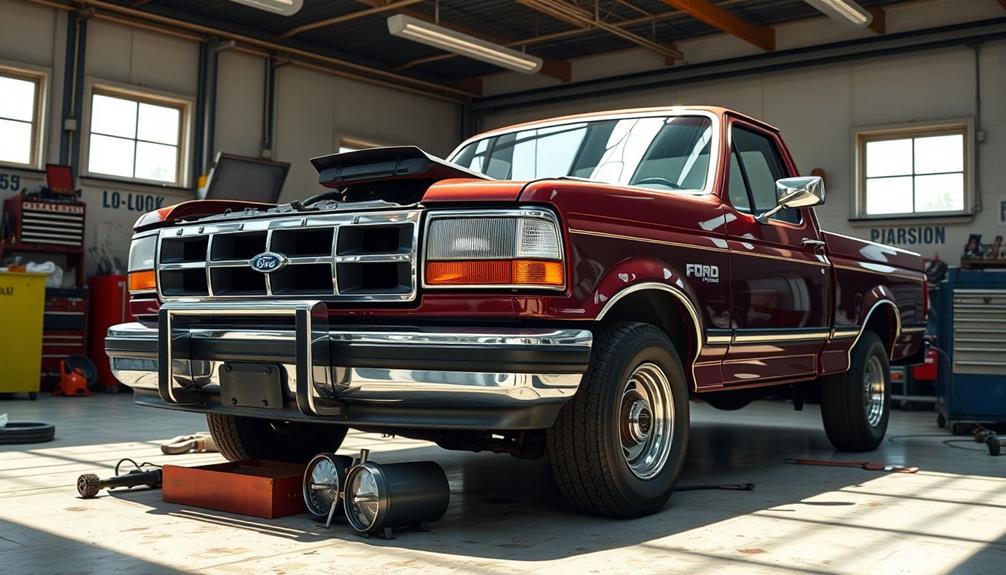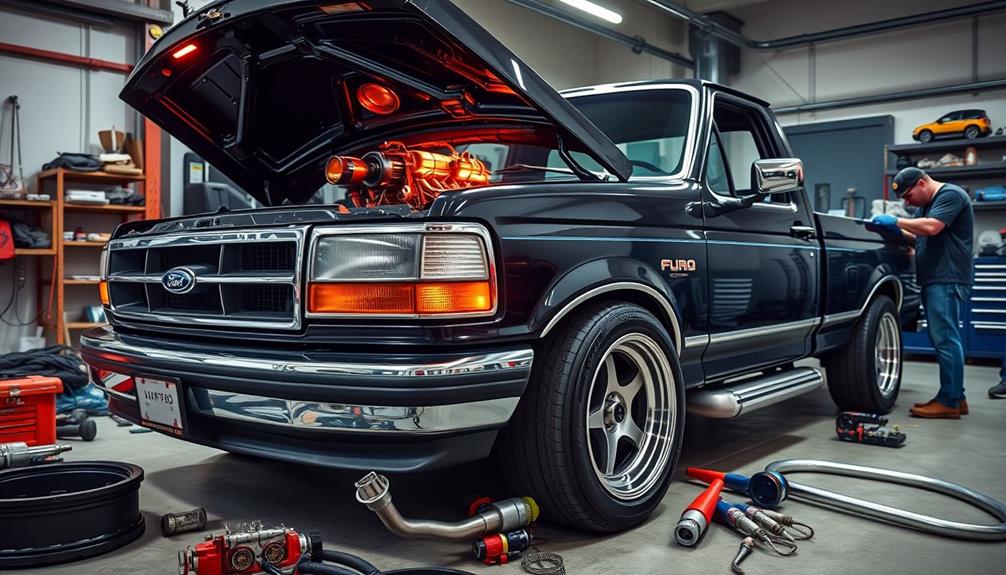Tuning your '94 Ford F150 can truly transform it into a powerhouse while preserving its classic vibe. Start with engine upgrades like a cold air intake or a larger throttle body to boost horsepower. Consider swapping in a 351W V8 for more torque, or enhance the current 5.0L with GT40 heads and performance headers. Keep your budget in mind, aiming for around $1,000 to $5,000 for solid modifications. Regular maintenance is key to longevity, so stay on top of oil changes and inspections. With the right upgrades, you'll reveal your truck's full potential, and there's plenty more to explore!
Key Takeaways
- Upgrade to a 351W V8 for increased torque and power, utilizing a straightforward drop-in replacement approach.
- Enhance airflow and performance with a cold air intake system and larger aftermarket intake manifold like GT40.
- Consider performance headers to improve exhaust flow, contributing to notable power gains while maintaining emissions compliance.
- Optimize engine performance with a performance camshaft and throttle body upgrades for enhanced air and fuel intake.
- Budget effectively for modifications, aiming for a total between $1,000 and $5,000 to achieve significant power improvements.
Overview of Engine Options
When it comes to tuning your 1994 Ford F150, understanding the engine options available is essential for maximizing performance. The stock engine typically is a 5.0L V8, equipped with a flat tappet cam and a different firing order than the Mustang's 5.0 HO engine. This setup features mass airflow (MAF) and roller lifters, enhancing efficiency and performance potential.
If you're looking for more power, consider swapping in a 351W V8. This engine nearly serves as a direct drop-in replacement, offering increased torque output that can greatly enhance your truck's capabilities. Low mileage stock 351 engines are particularly ideal for performance upgrades and can work wonders when paired with the right exhaust and intake manifold.
For those sticking with the 5.0L, upgrading to GT40 heads from a junkyard can give you a substantial boost, adding 20-40 horsepower over the stock E7 heads.
While the 302 engine reaches its maximum potential with its existing configurations, the right combination of upgrades can transform your F150 into a powerhouse ready to tackle any challenge.
Enhancing Performance With Upgrades

Enhancing the performance of your 1994 Ford F150 involves a variety of upgrades that can considerably boost horsepower and efficiency. One of the first steps you can take is to install a cold air intake system, which can add 5-8 HP while improving engine efficiency.
Next, consider replacing the factory intake manifold with a larger aftermarket option, like the GT40 upper and lower intake, to enhance airflow and increase overall power.
Installing performance headers, whether shorty or long tube, can also make a significant difference. They improve exhaust flow compared to stock manifolds, resulting in notable power gains.
If you want to take it a step further, a performance camshaft, such as the Comp Cam 31-255-5, can optimize engine performance, especially in EFI systems.
For those looking for dramatic increases, incorporating a supercharger or turbo system can push your horsepower by 100 HP or more, provided it's properly tuned and supported by your fuel system.
Each of these upgrades plays an essential role in transforming your classic truck into a powerhouse, making your driving experience more exhilarating than ever.
Assessing Engine Condition

Evaluating the engine condition of your 1994 Ford F150 is vital, especially if it's clocked 175,000 miles.
With signs of engine wear, like burning oil at a rate of 1 quart per 1200 miles, it's imperative to conduct a thorough assessment of your engine components.
Start by checking for leaks and measuring compression to gauge the overall health of your engine. Regular oil changes can help prolong its life, but you also need to inspect and replace any worn hoses and belts to maintain peak performance.
Don't forget to monitor coolant levels and verify your cooling system functions properly. Overheating can exacerbate existing engine wear and lead to more significant issues down the line.
If your engine shows substantial wear, rebuilding it may be necessary to guarantee reliable performance, especially if you plan on integrating modern power enhancements.
Taking the time to assess your engine condition now can save you from costly repairs later.
Budgeting for Modifications

Evaluating your engine's condition lays the groundwork for effective modifications, but you'll also need to think about budgeting for those upgrades. You can typically manage your budget under $5,000, which allows for a variety of enhancements including the exhaust system, air intake, and performance tuning.
To help you visualize where to allocate your funds, here's a simple breakdown:
| Modification Type | Estimated Cost | Potential Gain |
|---|---|---|
| Exhaust System | $500 – $1,000 | Improved airflow |
| Air Intake | $200 – $600 | Enhanced power |
| Performance Tuning | $300 – $800 | Optimized engine |
| Engine Swap (351W) | $1,500 – $3,000 | Significant boost |
Consider sourcing parts from junkyards or opting for used components to keep costs down. Prioritize modifications that offer the most noticeable performance improvements, like headers and cam upgrades. And remember to set aside extra funds for any unforeseen expenses, such as necessary upgrades to your fuel and cooling systems. By planning wisely, you'll guarantee a successful transformation of your Ford F150.
Transmission Compatibility Insights

When you're considering a transmission swap for your '94 Ford F150, you'll find the 4R70W transmission works seamlessly with both the 5.0 and 5.8 engines.
While the installation is generally straightforward, keep in mind that aftermarket parts can sometimes pose fitment challenges due to space limitations.
You'll also want to watch for minor adjustments needed for exhaust routing if you're going with the 351W engine.
Transmission Swap Compatibility
For those considering an engine swap in their 1994 Ford F150, understanding transmission compatibility is essential. The stock 4R70W automatic transmission works seamlessly with both the 302 and 351W engine swaps, providing a straightforward replacement process without needing significant modifications.
You'll appreciate that the transmission bolt patterns and mounting points are identical for both engines, making installation hassle-free.
When you swap in a 351W, you can retain your existing cooling and electrical systems, which means less rewiring and fewer cooling system changes. This convenience is a big plus for many DIY enthusiasts.
While the stock transmission can handle the power increase from the 351W, keep in mind that if you're planning a high-performance build, reinforcing your drivetrain components might be necessary.
However, you should be aware that some fitment issues could arise with aftermarket parts, especially concerning exhaust routing. You may need to make adjustments to accommodate the 351W, but overall, the compatibility of the transmission with both engine options guarantees you can achieve that modern power you're after in your classic truck.
Potential Fitment Challenges
Swapping in a 351W engine can throw a few curveballs your way, especially when it comes to fitment challenges. While the transmission remains compatible, you'll want to be aware of the following potential fitment issues:
- Exhaust Routing: The 351W may require adjustments in exhaust routing, which can complicate installation and affect performance.
- Engine Bay Space: The F150's engine bay might feel cramped, making it difficult to fit certain aftermarket parts without modifications.
- Aftermarket Parts Compatibility: Not all aftermarket components are designed with the 351W in mind, leading to potential conflicts that could delay your project.
- Drivetrain Strength: If you're planning on pushing high power levels, keep in mind the overall strength of the drivetrain, especially with the 4R70W transmission.
Setting Realistic Performance Goals

Setting realistic performance goals for your 1994 Ford F150 is vital to secure a successful tuning experience. When planning, aim for a reasonable horsepower increase of 20-40 hp. This can often be achieved by upgrading to GT40 heads or installing shorty headers.
Before diving into modifications, assess your engine's condition, especially if it has 154,000 miles on it. Understanding wear and tear will help you avoid costly failures down the line. Additionally, consider creating a personal budget to manage your tuning expenses effectively, as setting specific targets can keep you financially on track while enhancing your truck's performance.
Align your performance goals with your budget constraints. Effective upgrades, including exhaust modifications and a camshaft swap, can generally fit within a $1,000 to $5,000 budget.
However, keep in mind that significant power gains often require complementary modifications, like tuning the engine with a chip or adjusting fuel delivery systems.
Lastly, it's important to balance power improvements with maintaining smog compliance. Focus on modifications that allow you to keep the factory catalytic converters.
Supporting Modifications for Power

To maximize your 1994 Ford F150's power potential, consider implementing a range of supporting modifications that work together seamlessly.
These upgrades will enhance your truck's performance and guarantee that you get the most out of your tuning efforts.
Here are four key modifications to focus on:
- Throttle Body Upgrade: A larger throttle body can increase airflow by about 30%, greatly improving engine performance.
- Cold Air Intake System: Installing a high-flow cold air intake can provide a 5-8 horsepower boost while also enhancing engine efficiency.
- Shorty Headers: Swap out your stock manifolds for shorty headers to improve exhaust flow. This change can lead to better power output and a more aggressive sound.
- Mass Air Conversion: Upgrading to a mass air system allows for more precise tuning and compatibility with various setups, helping you achieve your desired power goals.
Researching Effective Upgrades

When you're researching effective upgrades for your '94 F150, it's vital to first identify your performance goals.
Whether you want more horsepower or better efficiency, exploring aftermarket options can help you achieve those targets.
Understanding what's available and how it fits your needs will guide your tuning journey.
Identifying Performance Goals
Achieving ideal performance in your 1994 Ford F150 starts with clearly defined goals tailored to your specific needs.
By pinpointing your performance goals, you can make informed decisions about upgrades that enhance your truck's capabilities.
Here are four key areas to focus on:
- Low-End Torque: Enhancing low-end torque is essential, especially if you're running larger tires or making gearing adjustments.
- Intake Manifolds: Upgrading to GT40 upper and lower intake manifolds can greatly boost horsepower while staying emissions-compliant.
- Exhaust System: Improving your exhaust system by replacing the y-pipe and adding high-flow catalytic converters can enhance exhaust flow and sound without violating smog regulations.
- Aftermarket Camshafts: Consider using aftermarket camshafts, like the Comp Cam 31-255-5, designed to elevate performance while remaining compatible with the factory EFI system.
Exploring Aftermarket Options
Exploring aftermarket options for your 1994 Ford F150 opens up a world of possibilities to boost performance and tailor your truck to your needs. One effective upgrade is a cold air intake system, which can provide a 5-8 horsepower boost by improving airflow and engine efficiency.
If you're looking for a more substantial power increase, consider installing a GT40 upper and lower intake manifold, which can potentially add 20-40 horsepower over stock components.
In addition to intake upgrades, incorporating shorty headers can enhance exhaust flow, delivering better performance while maintaining CARB compliance with certain models.
To further optimize engine performance, replacing your factory throttle body with a larger aftermarket throttle body, like a BBK option, can increase air and fuel intake by about 30%.
If you're ready to take it up a notch, think about adding a supercharger or turbo system. These setups can dramatically elevate horsepower, potentially adding as much as 100 additional horsepower and allowing for fine-tuning through mass airflow conversion.
With these options, you can truly transform your F150 into a modern powerhouse.
Community Resources and Support

Countless enthusiasts share their knowledge and experiences online, making community resources an invaluable asset for tuning your 1994 Ford F150. Engaging with these communities can help you identify effective upgrades and avoid costly mistakes.
Here are some key resources to explore:
- Online Forums: Sites like F150Forum and Ford Truck Enthusiasts offer extensive discussions on performance parts and engine modifications.
- Local Car Clubs: Joining a club can connect you with fellow enthusiasts who share tips and may even help with hands-on projects.
- Social Media Groups: Platforms like Facebook host groups dedicated to F150 tuning, where members often share their experiences and recommendations.
- YouTube Channels: Many tuners document their modifications, providing visual guides that can help you understand the process better.
Maintenance Tips for Longevity

Maintaining your 1994 Ford F150 is vital for ensuring its longevity and performance. Start with regular oil changes every 3,000 to 5,000 miles, depending on your driving conditions. Clean oil not only keeps your engine running smoothly but also extends its life.
Next, keep an eye on your coolant levels. A well-maintained cooling system prevents overheating, which can lead to severe engine damage.
Don't overlook the condition of your spark plugs. Periodically checking and replacing them can greatly enhance your engine's efficiency and performance, ensuring a smoother ride.
It's also important to inspect worn hoses and belts proactively. These components can fail and lead to serious engine issues if left unattended, so replace them before they cause problems.
Additionally, consider conducting pre-swap inspections of engine components like lifters and gaskets before any modifications. This practice helps prevent potential issues and maintains overall engine health.
Frequently Asked Questions
Can You Tune a 94 F-150?
Yes, you can tune a '94 F-150. While factory ECU tuning's limited, using programmers or making mechanical upgrades like better exhaust systems can boost performance. Just make sure to assess your engine's overall condition first.
How Can I Get More Power Out of My F-150?
To get more power out of your F-150, consider upgrading the intake manifold, installing shorty headers, adding a cold air intake, and optimizing the engine with a performance camshaft for improved airflow and efficiency.
What Does a Tuner Do for an F-150?
A tuner optimizes your F-150's engine by adjusting fuel mixtures and ignition timing. This enhances performance and efficiency, especially after modifications, ensuring your truck runs smoothly and delivers better throttle response and overall driveability.
What Is the Pulling Power of the Ford F150?
The Ford F150's pulling power varies by model but generally offers around 293 ft-lbs of torque. With modifications like performance upgrades, you can considerably enhance that pulling capacity for improved towing and acceleration.
Conclusion
In revamping your '94 Ford F150, you're not just tuning a classic; you're blending nostalgia with modern performance. Coincidentally, as you enhance power and efficiency, you might find yourself rediscovering the joy of driving that truck you've loved for years. Every upgrade you make brings a fresh thrill, reminding you why you fell in love with it in the first place. So, get out there, make those modifications, and enjoy the ride like never before! And if you really want to take your ford f150 ’98 tuning to the next level, consider adding some high-tech features that were never available in the ’94 model. Maybe it’s time to upgrade the sound system, add a navigation system, or even install a backup camera. These modern touches will enhance your driving experience even more and make you fall in love with your truck all over again. So go ahead and give your old Ford F150 a new lease on life!










